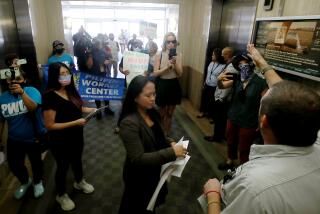Surveys Help San Diego Companies Keep Up on Pay Policies and Trim Their Turnover Rates
- Share via
SAN DIEGO — Several years ago, a North San Diego County manufacturer was astonished to learn that its employee turnover rate had risen to a staggering 77%.
That constant flow of new employees was forcing the company to spend ever-increasing amounts of money on training and quality control programs. And, the employer was making hefty contributions to the state unemployment insurance fund every time a new employee walked through the door.
Company executives eventually pared that turnover rate back to about 20% after taking part in a compensation practices survey conducted by the Compensation Practices Assn. of San Diego County, a group that has monitored compensation policies in San Diego since 1979.
“They learned that nearly all of their turnover came from (the factory floor) where they were using spouses of Marines--who were always being transferred out of town,” said N. Bruce Ferris, a co-founder of the association in 1979. “They analyzed their recruitment practices and changed them.”
Another survey, which focused on compensation packages, indicated that maintenance and production workers at another company in San Diego were being paid an hourly wage that was $1.50 below the prevailing hourly wage for like employees at a nearby competitor, Ferris said.
Those employees eventually gained union representation, but Ferris believes the company could have blunted the union’s appeal had company executives “taken steps to correct the salary situation.”
Compensation and turnover rates are “important information these days, even though the (Consumer Price Index) is relatively stable,” according to Ferris, Maxwell Laboratories’ personnel manager.
That kind of data has grown in importance to San Diego employers, according to Ferris, who is president of the association’s planning committee.
More than 50 San Diego employers--including Maxwell, SAIC?, Cubic and divisions of General Dynamics, Emerson Electric, Sony and Fujitsu--now participate in the association’s various compensation practices and turnover surveys. And more than 30 non-member companies in San Diego now buy compensation and turnover data from the association, Ferris said.
However, like most organizations that generate compensation data, the association stops short of selling it to unions or employee groups. “We dwell very heavily upon the proprietary nature of this information,” Ferris said.
Ferris founded the association nearly a decade ago because “the data just wasn’t being generated by anyone in San Diego.”
That absence of information was partially due to the ability of San Diego’s employers to “pay people in ‘sunshine dollars,’ ” Ferris said.
“We were selling San Diego as a beautiful place to live,” Ferris said. “But those days are gone and now you can’t live without the data. We have to compete with Los Angeles and Orange counties, and unless you pay competitive wages, you’re not going to keep growing.”
The association, one of a hundred or so groups now in existence nationwide, has drawn praise from compensation professionals for its ability to extract information and quickly process it.
“Not very many of (those firms) have the sophisticated survey that (Ferris) has developed,” according to Francis W. Miller, executive director of the American Compensation Assn., a Scottsdale, Arizona-based professional society. “The San Diego association is indeed unique in this country. And their turnaround time (on surveys) is dynamite.”
The association’s recent survey suggested that turnover in San Diego during 1987 fell by 0.2% to 15.1%, down from the group’s initial survey in 1979, when turnover was closing in on 30%. “The economic times have changed since then,” Ferris said.
The association generates several levels of data. Its turnover surveys, for example, indicate “how old the people are who are leaving a company, and why they’re leaving,” Ferris said. That information helps employers learn if they are “losing people with six to seven years of experience or simply the (entry-level employees) who you expect to lose.”
The association also surveys pay received by employees in 131 job classifications, Ferris said. Because the association limits membership to generally high-tech companies, “personnel people can compare apples to apples, instead of apples to oranges.”
Personnel directors want that kind of information because “in order to get approval to spend more money for certain categories of people, you need supporting evidence,” Miller said. “And the most valuable information you can get is what your competition is paying.”
In addition to keeping companies abreast of compensation practices at competing firms, the association’s surveys also track how members handle record keeping that is required by various state and federal agencies.
Unlike the San Diego Employers Assn., a nonprofit organization that conducts broader wage surveys, the Compensation Practices Assn. limits its membership to companies that are involved in manufacturing or research and development. Surveys include information about compensation packages granted to employees who fall below first-line supervisors.
The San Diego Employers Assn., with 1,700 corporate members, includes “everything from small, family-operated businesses to high-tech (companies),” according to Joseph Sczempka, the association’s human resources director. The association makes information from its surveys available only to its members, according to Sczempka.
More to Read
Inside the business of entertainment
The Wide Shot brings you news, analysis and insights on everything from streaming wars to production — and what it all means for the future.
You may occasionally receive promotional content from the Los Angeles Times.










